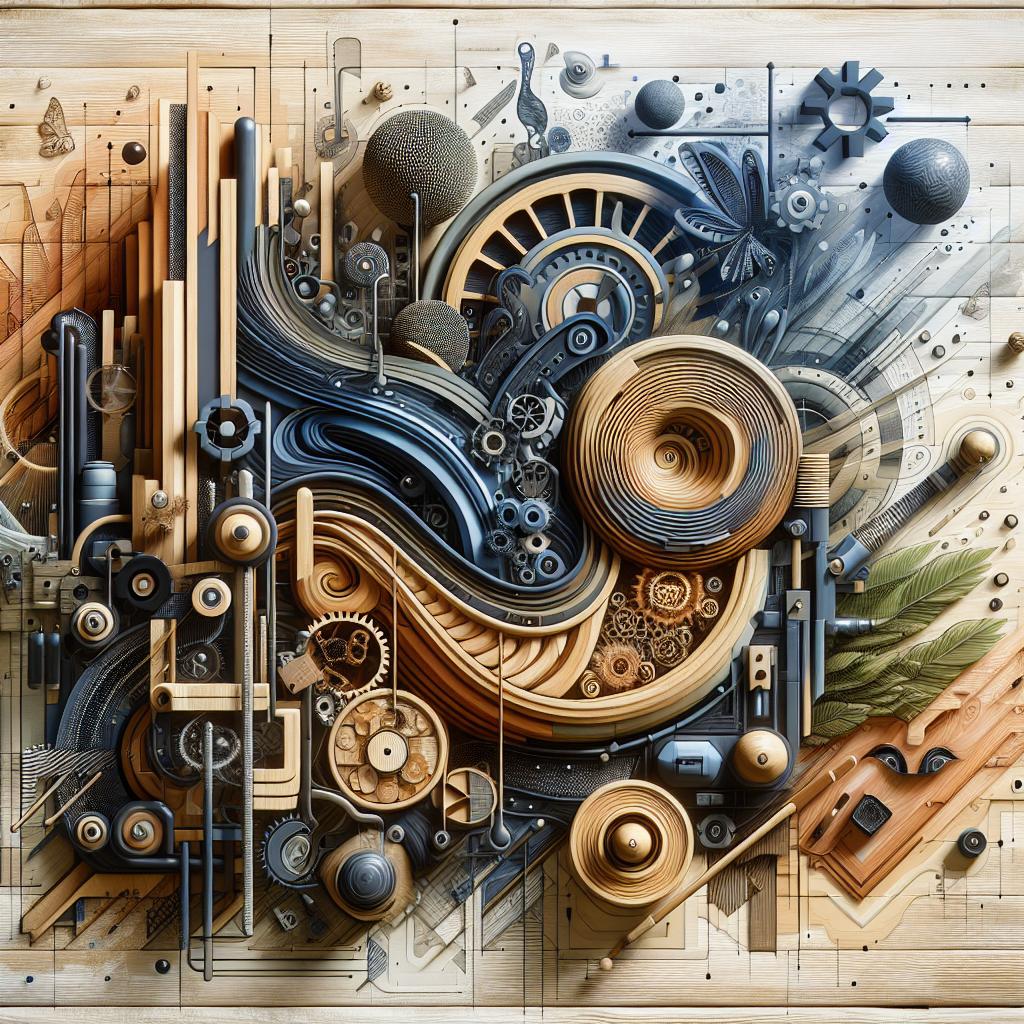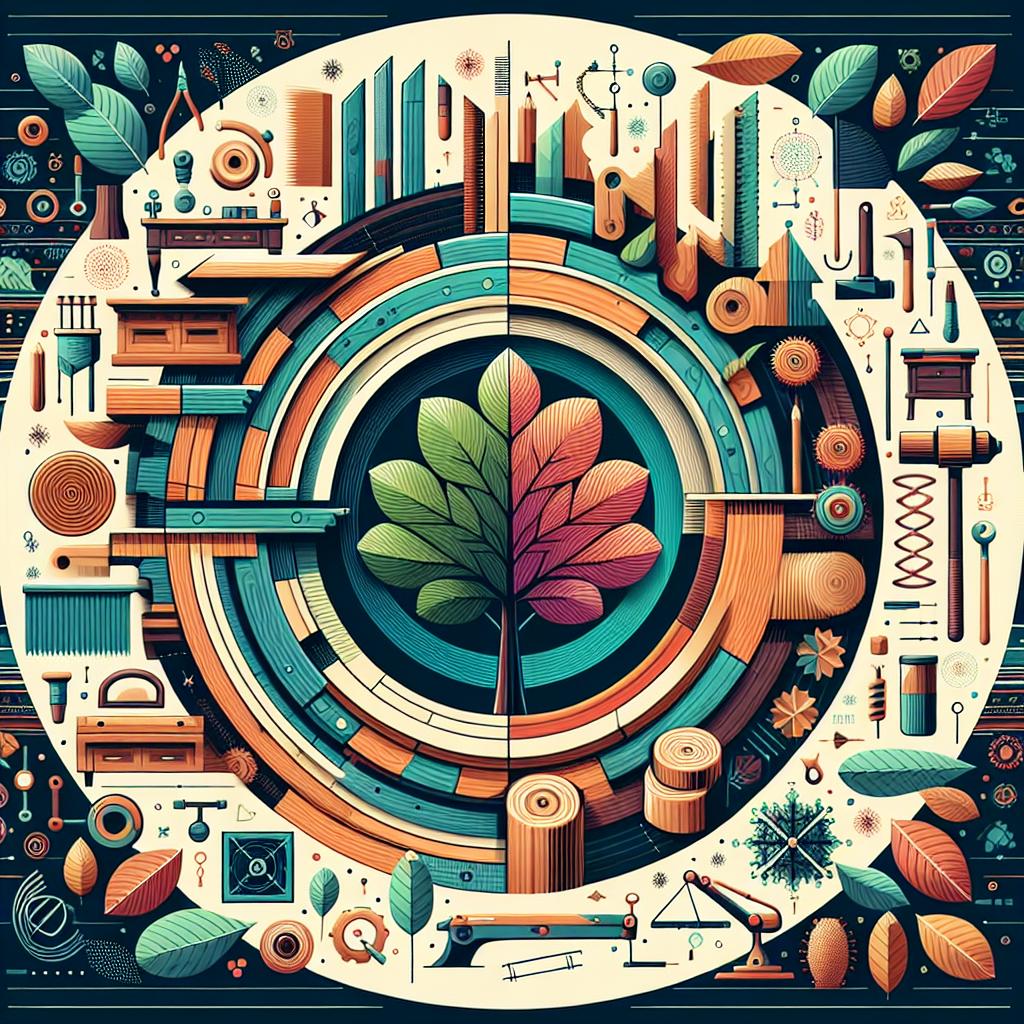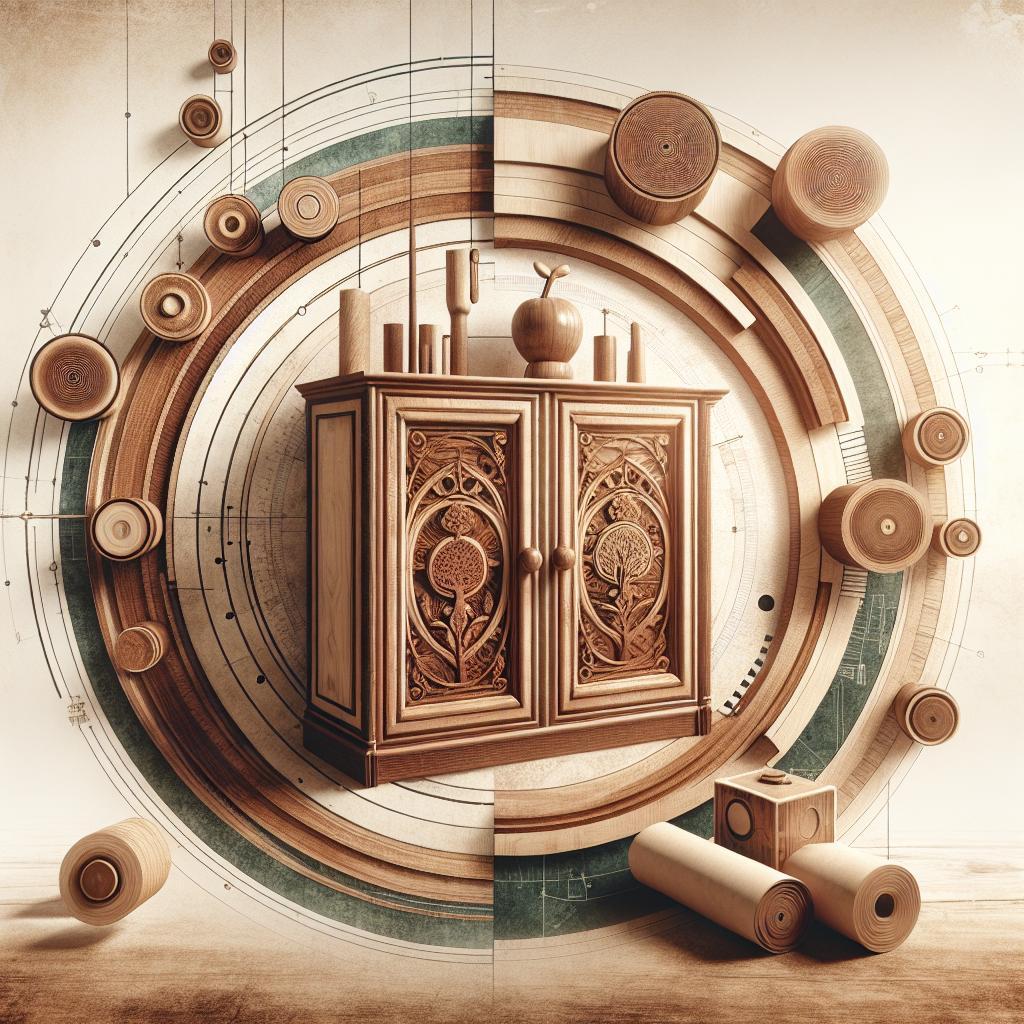Crafting Timeless Beauty: The Art of Cabinetmaking with Hardwood
In a world increasingly dominated by mass production and fleeting trends, the craftsmanship of cabinetmaking with hardwood stands as a testament to enduring artistry and practical design. This age-old practice not only showcases the natural elegance of timbers such as oak, maple, and cherry but also celebrates the skill of artisans who transform raw materials into functional works of art. From the intricacies of selecting the right wood to the final finishing touches that reveal the grain’s beauty, the process of creating hardwood cabinetry is both an intricate craft and a meditative journey. In this article, we will explore the essential techniques, tools, and philosophies that define the world of hardwood cabinetmaking, inviting you to appreciate the meticulous craftsmanship that has sustained this time-honored tradition through generations.
Exploring the Timeless Appeal of Hardwood in Cabinetmaking
When it comes to cabinetmaking, few materials evoke the same sense of elegance and durability as hardwood. The rich textures and natural grains found in hardwoods not only provide aesthetic appeal but also signify strength and longevity. Crafting cabinets from hardwood allows artisans to create pieces that are not just functional, but also serve as beautiful focal points in any space. Whether it’s the warmth of oak, the richness of cherry, or the exotic allure of mahogany, hardwood options provide a vast palette that caters to varied design preferences. Here are some of the most popular hardwoods used in cabinetmaking:
- Oak: Known for its strength and distinctive grain.
- Maple: Appreciated for its smooth texture and versatility.
- Cherry: Renowned for its warm tones that deepen with age.
- Walnut: Valued for its rich color and luxurious finish.
The craftsmanship involved in working with hardwood also demands a unique skill set, enhancing its allure within the woodworking community. The ability to manipulate hardwood into intricate designs, combined with techniques such as dovetail joints and inlays, elevates the craftsmanship to an art form. Beyond aesthetics, hardwood cabinets also offer practicality; they are easy to clean, resistant to moisture, and can endure the wear and tear of daily use. consider the following benefits when choosing hardwood for cabinetry:
| Benefit | Details |
|---|---|
| Durability | Long-lasting and resistant to damage. |
| Easy Maintenance | Simplified care with basic cleaning. |
| Timeless Design | Classic look that never goes out of style. |
| Eco-Friendly Options | Sustainably sourced hardwoods available. |
Essential Tools and Techniques for Crafting Stunning Hardwood Cabinets
To elevate your cabinetmaking skills with hardwood, having the right tools is paramount. A few essential tools that every woodworker should incorporate into their workshop include:
- Table Saw: Ideal for making precise straight cuts and ripping larger panels.
- Router: Perfect for adding decorative edges and making intricate joinery.
- Chisels: Essential for cleaning out joints and achieving fine detail work.
- Drill Press: Ensures accuracy when drilling holes for hardware.
- Clamps: Crucial for holding pieces together while the glue sets.
Beyond tools, mastering various techniques will significantly enhance the quality of your cabinets. Here are some techniques to focus on:
- Joinery: Explore dovetail and mortise & tenon joints for exceptional strength and aesthetics.
- Sanding: Proper sanding techniques can elevate the smoothness and prepare the wood for finishing.
- Finishing: Experiment with stains, oils, and lacquers to bring out the natural beauty of the hardwood.
| Tool | Purpose |
|---|---|
| Table Saw | Precision cuts |
| Router | Decorative edges |
| Chisels | Detail work |

Choosing the Right Species: A Guide to Popular Hardwoods for Furniture
When it comes to cabinetmaking, the selection of hardwood species plays a crucial role in the overall aesthetic and durability of the furniture. Some popular choices among craftsmen include:
- Oak: Known for its strength and prominent grain patterns, oak is a classic choice that exudes a sense of tradition.
- Maple: Offering a fine, consistent grain, maple is ideal for modern designs and is highly resistant to wear.
- Cherry: Renowned for its rich color that deepens over time, cherry is often favored for high-end furniture due to its natural beauty.
- Walnut: Valued for its luxurious appearance and workability, walnut adds a touch of sophistication to any piece.
Each type of hardwood brings unique qualities that can enhance your project. For instance, Birch is a versatile hardwood that’s affordable and boasts a smooth finish, making it an excellent option for painted furniture. On the other hand, Teak is famous for its weather-resistant properties, making it perfect for outdoor cabinets. Below is a comparison table to help you visualize the characteristics of these wood types:
| Wood Type | Color | Grain Pattern | Durability |
|---|---|---|---|
| Oak | Light to medium brown | Prominent | High |
| Maple | Light creamy color | Fine | High |
| Cherry | Warm reddish-brown | Straight | Moderate |
| Walnut | Dark chocolate brown | Wavy | High |
| Birch | Light yellow-brown | Straight | Moderate |
| Teak | Golden to brown | Straight | Very High |

Finishing Touches: Protecting and Enhancing Your Hardwood Creations
To ensure your hardwood creations maintain their beauty and durability, it’s essential to apply protective finishes that enhance their natural grain while guarding against damage. Here are some popular options to consider:
- Oil finishes: These penetrate the wood for a rich, warm appearance. Tung oil and Danish oil are great for enhancing grain and providing modest protection.
- Polyurethane: Ideal for a tough, clear coat that stands up to wear and spills. Available in both oil-based and water-based formulations.
- Lacquer: Offers a brilliant, glossy finish that dries quickly. It’s perfect for achieving a smooth texture, though it may require more frequent reapplications.
- Varnish: This option provides excellent UV protection, making it suitable for pieces exposed to sunlight.
Beyond just protection, finishes can also enhance the visual appeal of your hardwood pieces. Consider the effects of different finishes when applied, which are summarized in the table below:
| Finish Type | Appearance | Durability |
|---|---|---|
| Oil | Warm & natural | Moderate |
| Polyurethane | Clear & glossy | High |
| Lacquer | Brilliant & shiny | Low to moderate |
| Varnish | Rich & warm | High |
Choosing the right finish will not only safeguard your work but will also play a crucial role in how the final product is perceived. Always test a small area before full application to ensure the desired effect aligns with your vision for the piece.
Q&A
Q&A: Exploring the World of Cabinetmaking with Hardwood
Q: What exactly is cabinetmaking with hardwood?
A: Cabinetmaking with hardwood is a specialized craft that involves the design, construction, and finishing of furniture and cabinetry primarily using hardwood species like oak, maple, cherry, and walnut. This form of woodworking combines artistic design with technical skill to create durable, aesthetic pieces suitable for both functional and decorative purposes.
Q: Why is hardwood preferred over softwood in cabinetmaking?
A: Hardwood is favored for cabinetmaking due to its density, durability, and rich aesthetic qualities. Unlike softwoods, hardwoods often possess complex grain patterns and colors, making them ideal for furniture that is intended to be both functional and visually appealing. Additionally, hardwood is less prone to warping and scratching, which enhances the longevity of cabinets and furniture.
Q: Can you tell me about the tools used in cabinetmaking?
A: Cabinetmaking requires a variety of tools. Essential items include table saws for straight cuts, routers for edge shaping, chisels for detail work, and sanders for smooth finishes. Planers and jointers are also crucial for preparing wood surfaces, while clamps and measuring tools ensure precision in construction. Advanced cabinetmakers may use CNC machines for intricate designs and large-scale projects.
Q: What are common joinery techniques in cabinetmaking?
A: Joinery techniques are vital in ensuring structural integrity and aesthetic appeal. Common methods include dovetail joints, finger joints, and mortise-and-tenon joints. Each technique offers unique benefits; for instance, dovetail joints are known for their strength and resistance to pulling apart, making them ideal for drawer construction, whereas mortise-and-tenon joints provide robust connections for frames.
Q: How does one finish hardwood cabinets?
A: Finishing hardwood cabinets involves a process of sanding, staining, and sealing to enhance the wood’s natural beauty and protect it from wear. Firstly, cabinets are meticulously sanded to create a smooth surface. Next, a stain can be applied to achieve the desired color, and a topcoat—such as polyurethane or lacquer—is added to provide durability and resistance against moisture and scratches.
Q: What are some environmental considerations in using hardwood for cabinetmaking?
A: Responsible sourcing of hardwood is critical in sustainable cabinetmaking. It’s essential to choose hardwoods from certified sustainable forests to minimize environmental impact. Additionally, craftsmen can utilize reclaimed wood, which reduces waste and preserves the character of older trees. Being mindful of finishes and adhesives is also crucial, as some products may contain harmful chemicals.
Q: How can someone get started in cabinetmaking with hardwood?
A: For those interested in beginning cabinetmaking, it’s beneficial to start with foundational skills in woodworking. Enrolling in woodworking classes or workshops can provide guidance on techniques and tool usage. Additionally, investing in basic tools, starting with small projects, and gradually taking on more complex pieces can help develop the necessary skillset. Connecting with local woodworking communities can also offer support and inspiration.
Q: What are some of the trends in cabinetmaking today?
A: Current trends in cabinetmaking often emphasize a balance between traditional craftsmanship and modern aesthetics. Minimalist designs with clean lines are gaining popularity, as are finishes that emphasize the natural grain of the wood. Eco-friendly practices and the use of sustainable materials are also trending, with more craftsmen focusing on creating pieces that are not only beautiful but also environmentally responsible.
Q: How can I maintain my hardwood cabinets over time?
A: Maintaining hardwood cabinets requires regular care to preserve their beauty. Dust and clean surfaces with a soft cloth to avoid abrasions. Using pH-balanced cleaners specifically designed for wood can help maintain the finish. Additionally, it’s advisable to apply a new coat of finish or polish periodically to protect the wood and revive its luster. Avoid placing hot objects or excessively wet items directly on surfaces to prevent damage.
Through this exploration of cabinetmaking with hardwood, we gain insight into a timeless craft that marries artistry with functionality. Whether you’re a seasoned woodworker or a curious novice, the world of hardwood cabinetry holds endless possibilities for creativity and craftsmanship.
Key Takeaways
As we close the door on our exploration of cabinetmaking with hardwood, we hope this journey through grain and craftsmanship has inspired your own creative endeavors. Whether you’re a seasoned artisan or a budding hobbyist, the beauty of hardwood and the art of cabinetmaking offer endless possibilities for expression and functionality.
Remember, every piece of wood carries its own unique story—each knot and swirl telling tales of its past. Embrace the patience and precision it requires, and let your imagination guide you through the process. As you embark on your projects, may you find joy in the tactile nature of the materials and satisfaction in the life your creations bring to spaces.
With tools in hand and a vision in mind, the heart of your craft beats stronger with each piece you create. Here’s to the spirit of woodworking, the beauty of hardwood, and the endless potential that awaits within every grain. Happy crafting!

